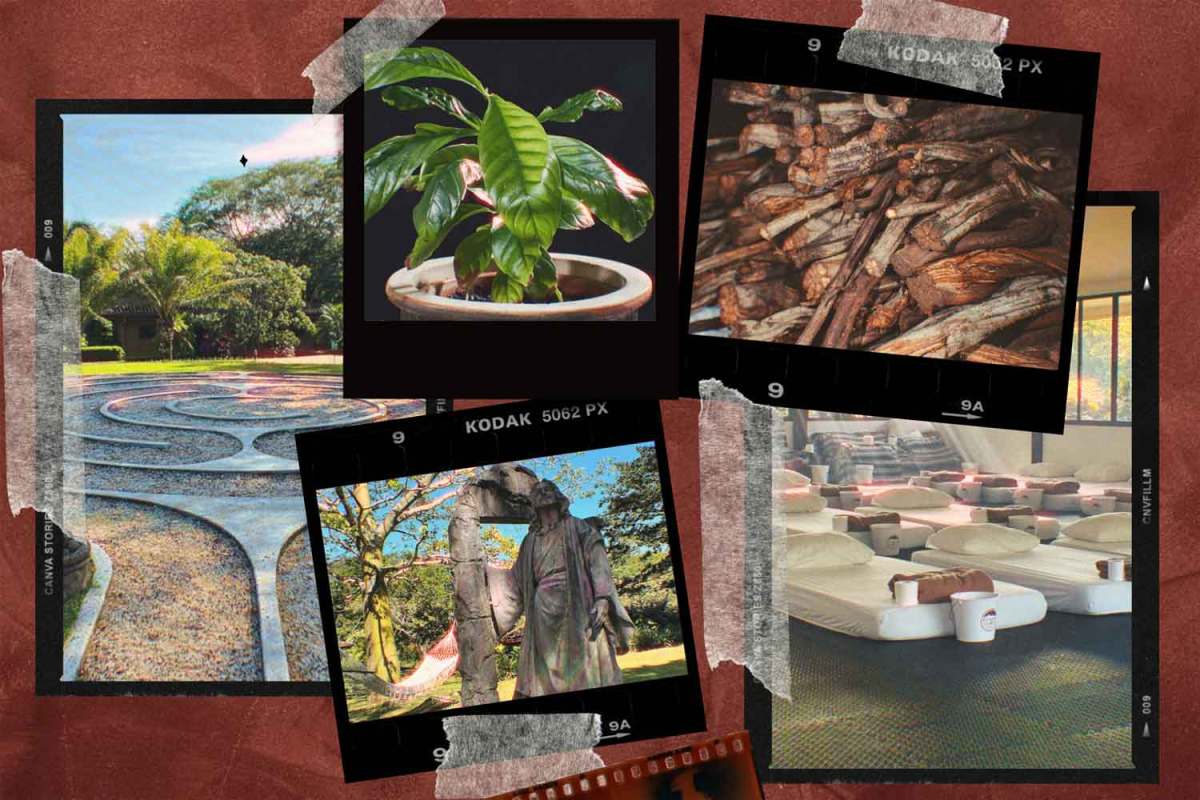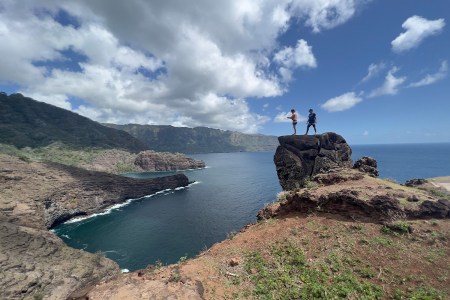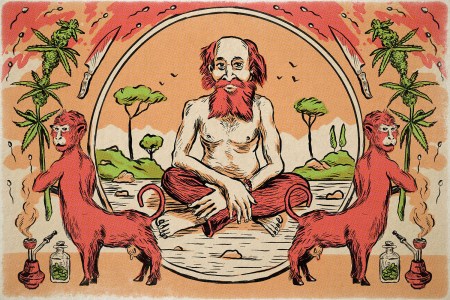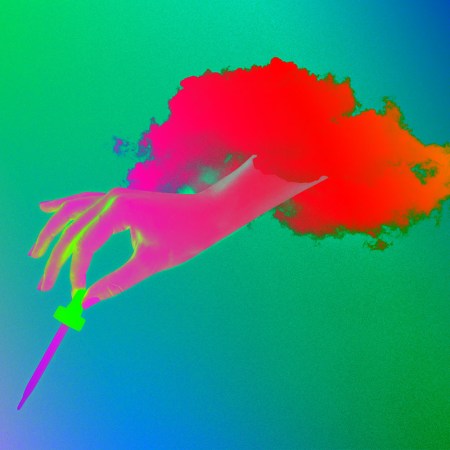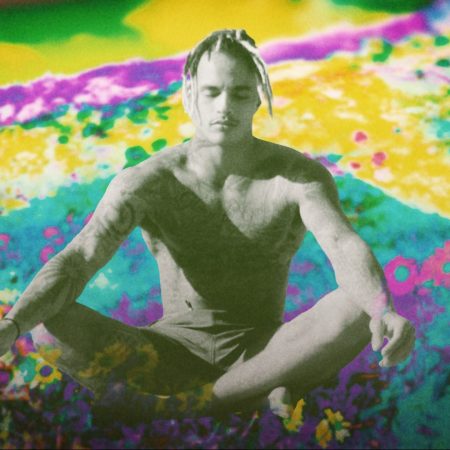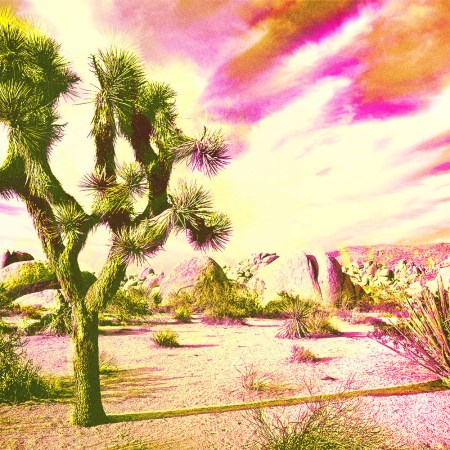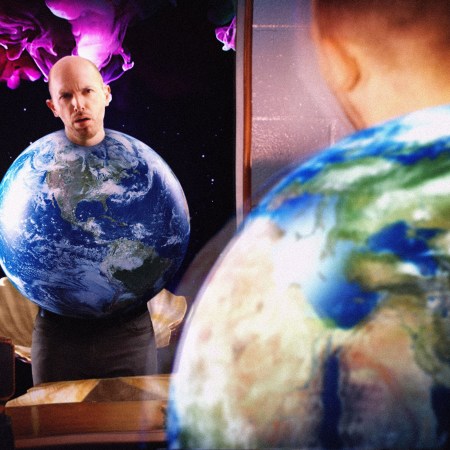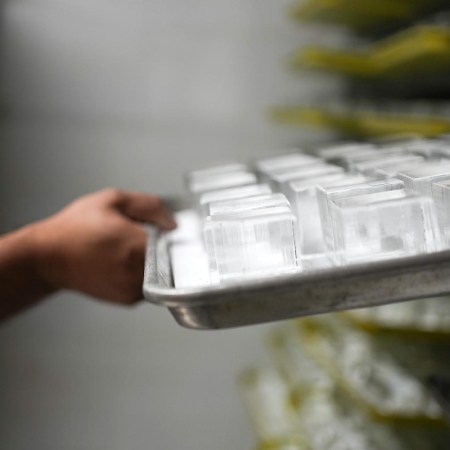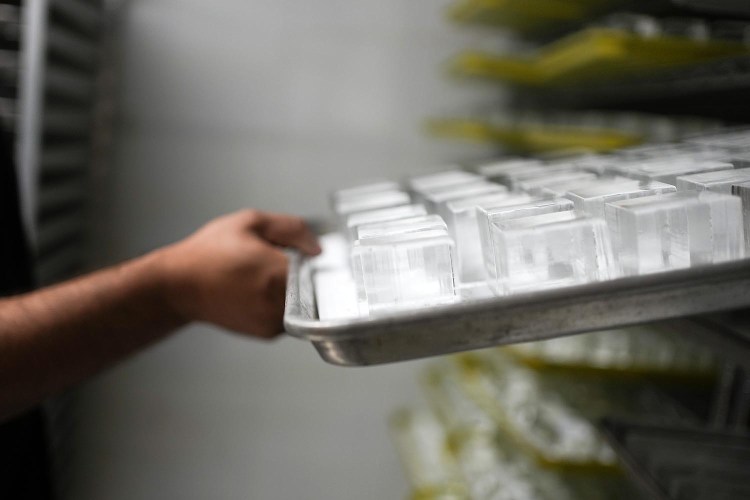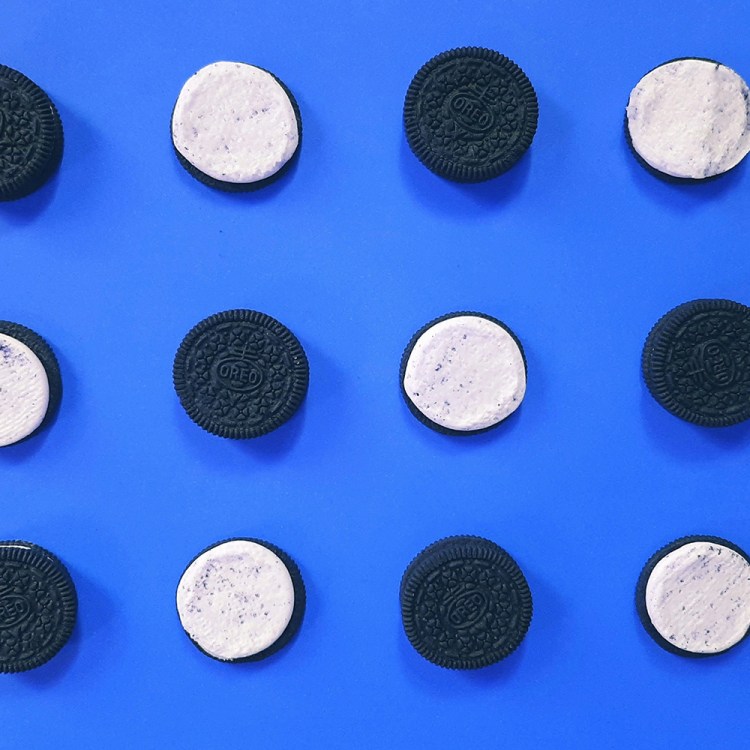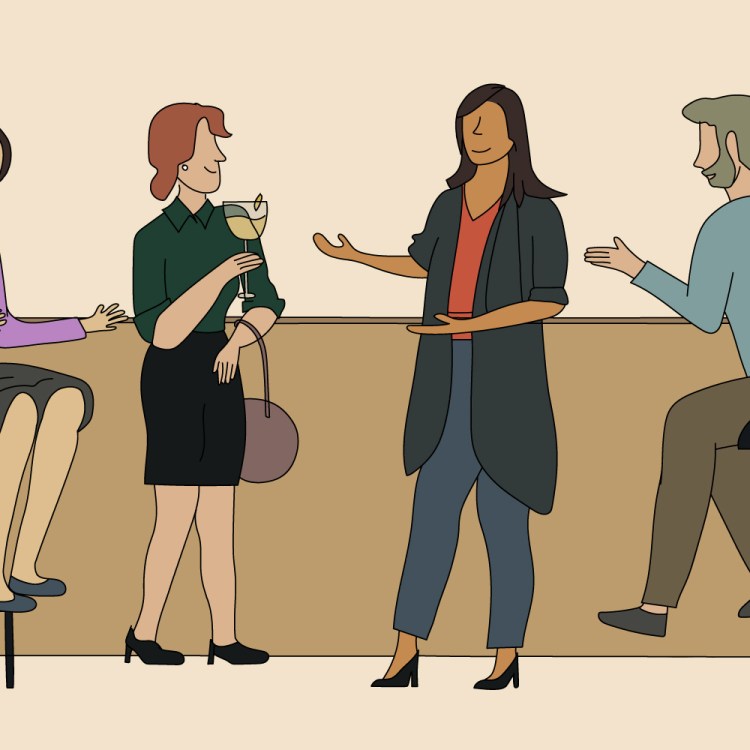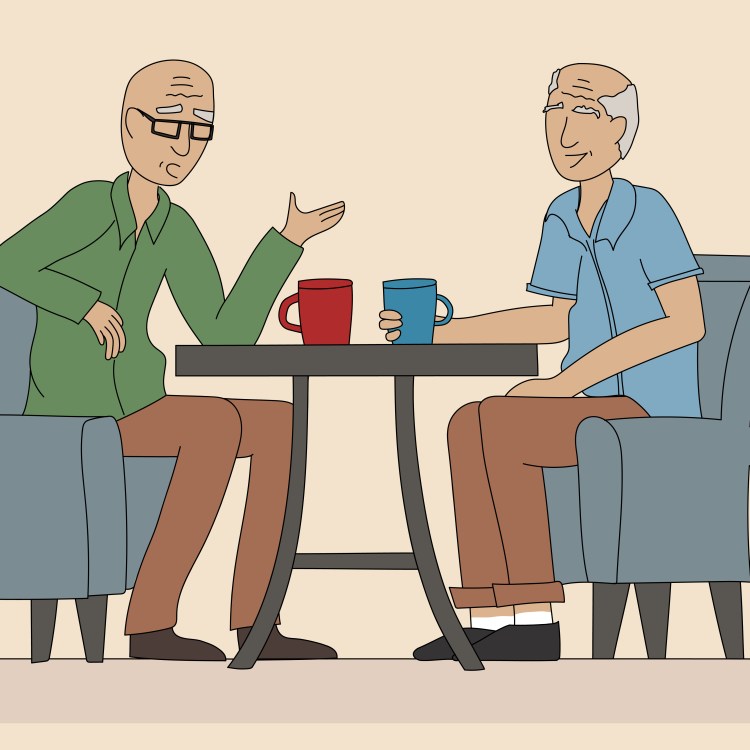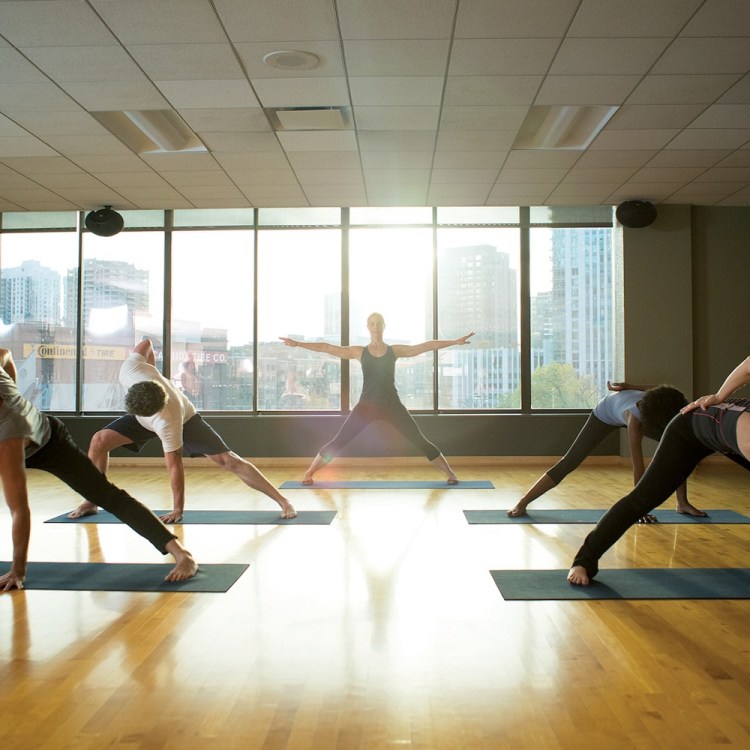I can’t stop crying and I don’t quite know why. I just know that I want to let it all out. The shaman motions for me to sit and wait for her on a padded stool, then serves the others a third cup of a psychedelic plant medicine we’re all here to drink. She places a bucket at my feet, but I don’t feel nauseous. I just can’t stop the tears.
Has it been five minutes? Or an hour? The shaman sits facing me and I point to my left side under my ribs. Something is stuck there. A feeling. A fear.
There are dried tobacco leaves brushing my skin. Thick smoke, water and oils dance around me through her hands. A moment of clarity rushes in that this is all so utterly bizarre but somehow very familiar.
When she’s done, she hands me another cup of the elixir. It tastes of bitter earth, bark and mushrooms, with a hint of cacao. The consistency of an espresso shot.
I feel it coming back up while walking to my cushion and I burst into a jog, then a sprint through the dimly lit room, dodging people and beds. I skid on my knees to the purge bucket and empty my gut. Through the open door in front of me the stars seem unusually bright, beckoning. Who am I to refuse? I pull my blanket with me like a toddler and walk out to lay in the grass to hear what they have to say.
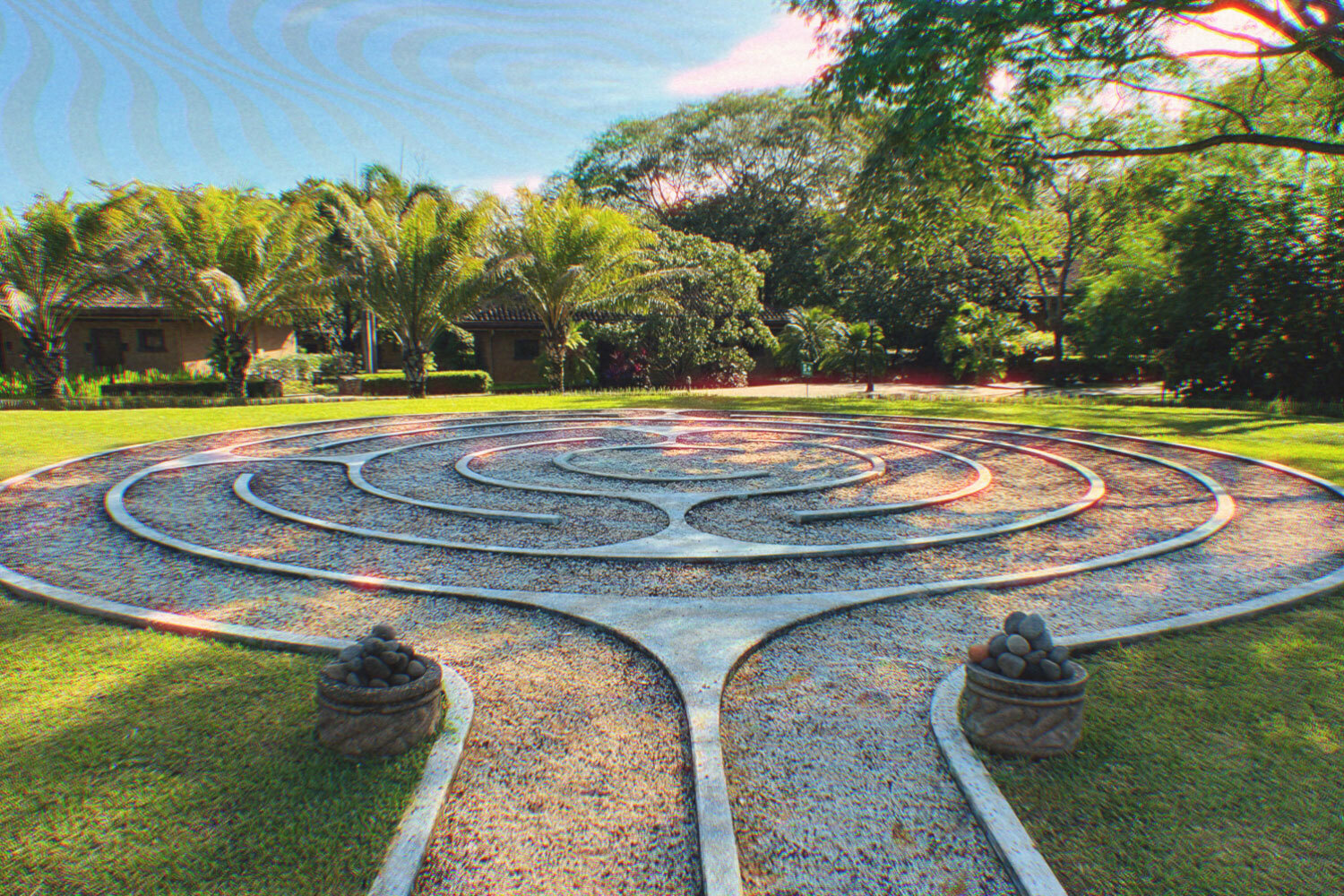
Part One: The Invitation
“This is the future of healing.”
“You want to go into the jungle to do drugs?”
These were the two sides of commentary I received as I contemplated accepting a press trip to a wellness center in Costa Rica. This was no weekend of sand and surf — I was offered the chance to spend four nights drinking ayahuasca, an ancient plant medicine and potent psychedelic extolled for its healing properties, in particular the treatment of depression, anxiety and PTSD.
Ayahuasca means “vine of the soul” or “vine of the dead” in Quechua, the language native to the indigenous people living in the Andean highlands throughout Peru, Ecuador, Bolivia and elsewhere. I’d heard the psychoactive tea touted by some to offer the equivalent of 20 years of therapy in four days. My logical brain balked at the lack of quantifiable data for such a claim, but clearly there was something to it — it kept popping up in the news, and several U.S. states were attempting to decriminalize it. From what I understood, it isn’t a fun recreational drug when used according to indigenous practices, unless you enjoy projectile vomiting for hours and facing your most torturous demons, even ones you didn’t remember (which is always a nice surprise). Unlike alcohol and weed that are considered escapist, this tea supposedly makes you fast-track your traumas so you can purge them, literally.
In my mind, I pictured a rollercoaster into a zombie apocalypse with a side of shitting your pants, and the hope of a spiritual awakening when you come out the other side. I was also advised to quit coffee in advance. Not exactly my idea of a vacation. So why would anyone choose to do this? For those in need of some serious inner recalibration, ayahuasca has recently come to be considered in Western society as a means of psychological healing when nothing else works.
It’s not uncommon for journalists to be invited to these sorts of things, even experiences as potentially extreme as this. I was intrigued by this particular trip because I was familiar with the retreat center in question, Rythmia — located in the Guanacaste province of Costa Rica and touting a board of directors with notable names like Kelly Slater and Martin Luther King III — and had been eyeing it keenly for years, for a number of reasons.
Ayahuasca is illegal, controlled or languishing in some massive gray area in most countries. The brew contains DMT, a schedule I substance in the United States, making ayahuasca illegal under federal law. That has not stopped countless retreat centers worldwide from offering the elixir as a form of healing, many using religious freedom as a loose protection. In Rythmia’s case, the center holds a medical license to administer ayahuasca from the Costa Rican Ministry of Health; by the time I set foot on the green, manicured lawns in December 2023, over 15,000 participants had come through its doors. As the largest ayahuasca wellness center in existence, seeing patients since 2015, they have collected more anecdotal data on how this plant medicine works than anyone else in the world.
I free-dive, backpack solo and travel across the world, sometimes having to chainsaw through jungles and dive 80 feet into the ocean on a single breath. But somehow, my attending a wellness retreat with plant medicine sparked more warnings than any of the above.
I read countless articles, blogs and social media posts about this place. Most were over the moon, glowing and raving about soul rebirths and new lives lived; a few were discouraging, gloomy and outright antagonistic. Pro or con, these visceral reactions fascinated me. On the scientific side, there has been rigorous research into the use of psychedelics, plant medicines and alternative therapies — including MDMA, psilocybin, ketamine and, of course, ayahuasca — as a form of mental-health therapy, something sought out by a significant portion of the population these days. The results of several studies focusing specifically on ayahuasca — in journals like Scientific Reports, Progress in Neuro-Psychopharmacology and Biological Psychiatry and Frontiers in Pharmacology — have been so positive they are impossible to ignore.
Then there’s Eric Sanchez, a close family friend of mine and veteran who served 20 years in the U.S. Navy. I was vaguely aware that he was struggling in his post-military life, and we had discussed plant medicine once or twice. When I heard he had gone to Mexico to try ayahuasca, I reached out immediately, curious if it had an impact. The bubble indicating he was texting hovered and vanished until I thought he had forgotten. Then, he gave me the full backstory to the damage his military career had left him with and how a plant had trumped any standard treatment offered to put the pieces back together.
“I was deployed to Iraq in 2003 and Afghanistan twice (2010/2011),” Eric texted me. “I was diagnosed with PTSD, depression and anxiety in 2012 and went on and off psychotherapy for nine years. I knew something needed to change…. I came across the opportunity to try ayahuasca (in December of 2022) and it transformed my life completely!!! In three days, I stopped all addictive behaviors, stopped using alcohol, cannabis and stopped eating meat. I was able to heal some deep traumas that dated from childhood while working (through) some military trauma as well.”
He isn’t alone in his ayahuasca awakening. At the time I was considering the trip, acclaimed journalist Lisa Ling had recently reported for CBS News about veterans crossing the border to Mexico where they were administered therapies not legal in the U.S., including ayahuasca. The results were life-altering. Many credited the experiences with saving their lives. This didn’t sound like fluff or the latest hipster bandwagon. It was starting to feel like it required a closer look.
A One-of-a-Kind Adventure Deep in French Polynesia’s Remote Marquesas Islands
Our correspondent explores fascinating tribal history and encounters unexpected thrills in a destination 900 miles from any 5-star resortsNow, I live in Los Angeles, where ayahuasca “retreats” can be had any night of the week. From the remote, green hills of Topanga Canyon with bohemian chic vibes to more plush settings in the heart of Beverly Hills, spiritual influencers with thousands of social media followers will guide you through your journey. These experiences aren’t legal, but if you have a few grand to spend and know who to ask, they are easily accessible. Being outside the law, it’s a confusing and diluted field. It’s also hard to know what you’re getting and from whom — so the concept of a retreat center where thousands of people had come before me, with abundant data, which would imply safety and efficacy, was tempting.
The main undertow pulling me to Rythmia, though, is the simple fact that if I were a cat, I would have spent my nine lives ages ago. Curiosity always gets the best of me.
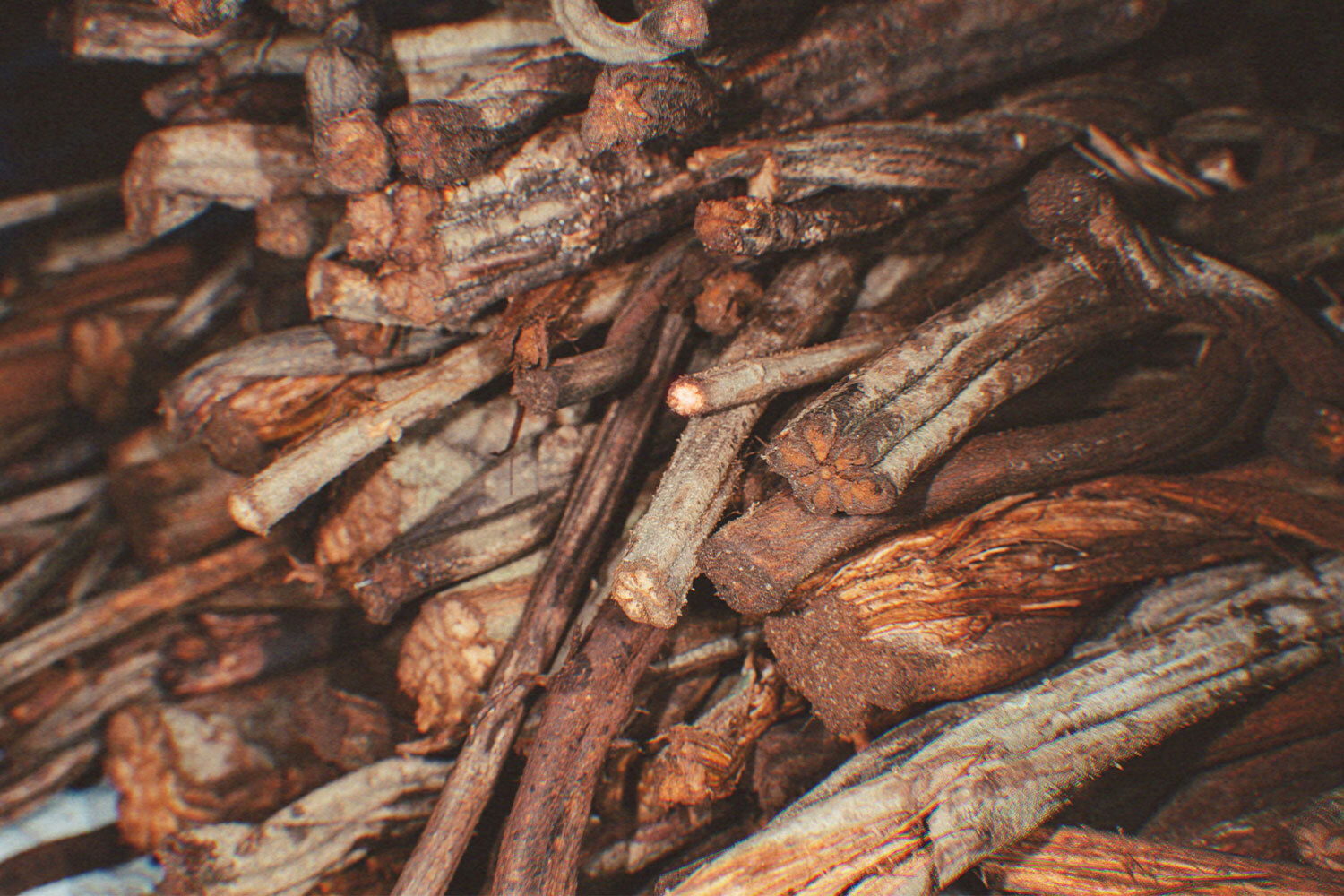
Part Two: The Plant
So what is ayahuasca, exactly? The short answer: It’s a potent psychedelic drink made of two plants native to the Amazon basin, the Banisteriopsis caapi vine and the Psychotria viridis flowering shrub.
The more complex history goes like this: The use of ayahuasca historically spread across Amazonia dating back to the original populations of South America. The earliest archaeological evidence of ayahuasca use was found in Bolivia and dates back a thousand years.
The psychoactive blend has been used in rituals by these indigenous peoples for healing, communicating with spirits, religious rites and initiations. Ceremonies consist of a shaman mixing and blessing the medicine, sitting with the participants and consuming the decoction. Within an hour of consumption, vomiting and diarrhea can occur, often violently, followed by visions and revelations, sometimes seen as connections to a higher entity.
Where do the mental-health benefits come from? The bark of the Banisteriopsis caapi vine has an antidepressant effect that changes the levels of brain chemicals norepinephrine, serotonin and dopamine, all neurotransmitters. Caapi is boiled with leaves of the Psychotria viridis bush, the latter containing DMT, which give the mix hallucinogenic properties. Sip these two beauties and boom — you’re said to feel one with the source and face some deep digging into your soul. Fast forward a thousand years, and the practice has made its way into modern healing and enlightenment-seeking sensibilities across Europe and North America.
With potentially a thousand years of use behind it, why is it still so controversial? Psychedelics have never played well with policymakers, especially in the last 50 years. Legality is the main deterrent to use, but there are a few more complexities to this relationship. Research on ayahuasca is promising, but outside of anecdotal experiences and a handful of solid, clinical studies, the science is only just getting started. It’s difficult to hold large-scale, well-funded experiments using controlled substances — and limited data is a problem. Our brains desperately grasp for understanding and fear the unknown. It’s basic survival.
Yet, the better studied side of medicine isn’t always coming up roses, either. Prescriptions for everything from antidepressants to thyroid medications, two of the most prescribed drugs in the U.S., seem to be handed out like hotcakes. When you get into mental-health care, you open Pandora’s box of insufficiency, especially in certain demographics. One troubling statistic: suicide rates of military veterans are almost double that of non-veterans.
Despite the abundance of available psychiatric drugs and therapies, levels of depression and anxiety are extremely high, particularly in developed nations in the aftermath of the pandemic. We are facing a tidal wave of mental-health meltdown and our current life preservers aren’t doing the job. To seek solace and respite from modern maladies, people seem to be revisiting ancient practices with greater urgency.
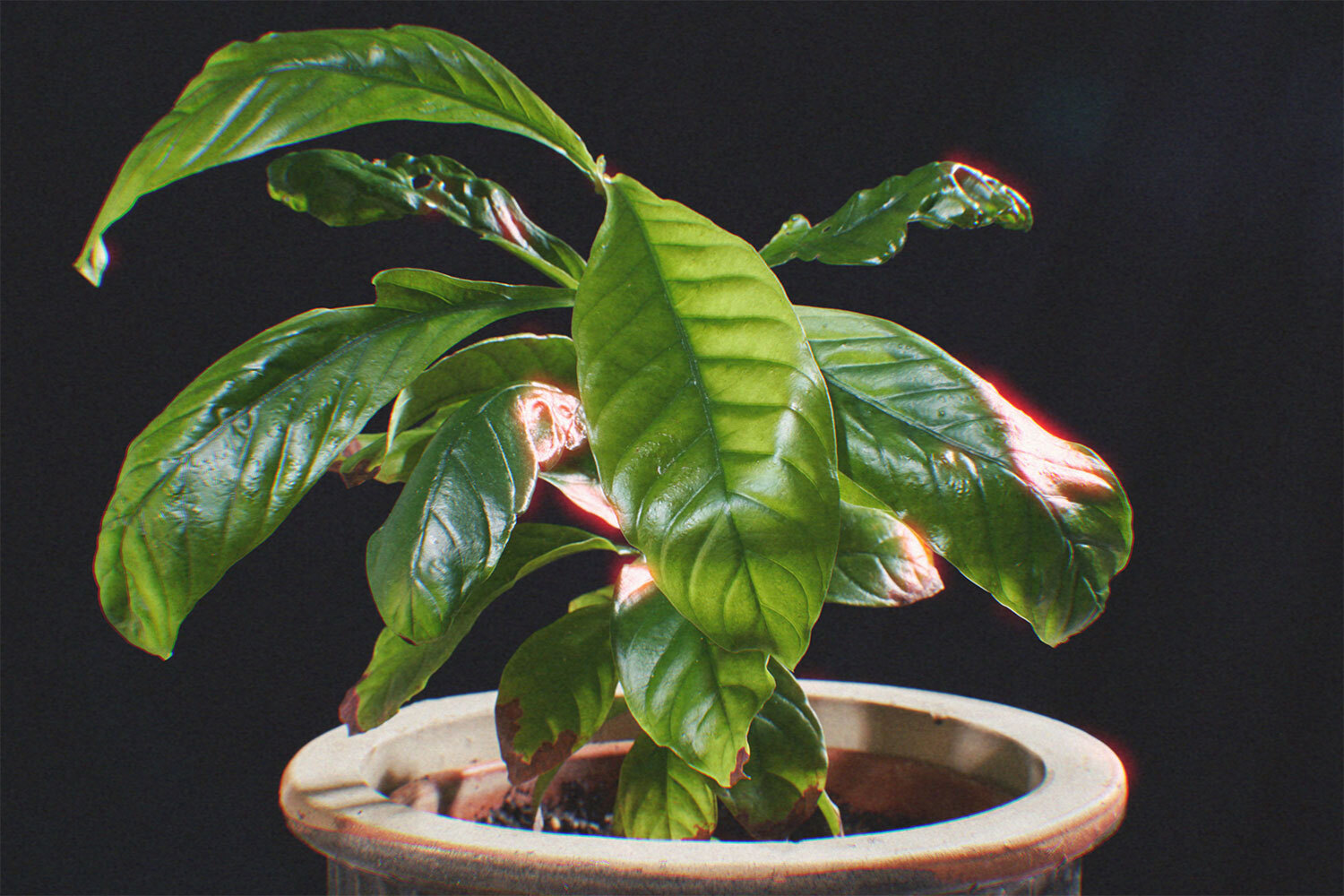
The growing awareness around ayahuasca, though, means more people with strong opinions. When I began to talk openly about attending the retreat, I was warned, scoffed at and side-eyed. I even had my journalistic integrity questioned — why would I engage in such practices that are not fully understood? Everyone seemed to have something to say about ayahuasca, psychedelics and Rythmia specifically.
The concern for my safety was astonishing. My life isn’t an average walk in the park. I host Shark Week shows for Discovery — a career choice that involves swimming with 2,000-pound tiger sharks. I also free-dive, backpack solo and travel across the world, sometimes having to chainsaw through jungles and dive 80 feet into the ocean on a single breath. But somehow, my attending a wellness retreat with plant medicine sparked more warnings than any of the above, which only made me more determined.
Also intriguing is the human desire to seek enlightenment, guidance and forge a connection to the divine, whatever form that might take. Throughout our history we have always had a pull to the occult and no culture has ever existed without mythology, sacred beliefs, spiritual leaders, saints, healers or a slant towards what we would call the paranormal. Simply put, we love magic and desperately want it to be real, but we are also deeply terrified of it, because it doesn’t come with an instructional pamphlet. Even things firmly established in our current bubble of understanding were once lore. The deep sea was historically thought to be brimming with sea monsters and mermaids, until we identified and labeled them more benign names such as whales and manatees.
Not all ayahuasca is wrestling with demons. For many, there is also a connection to what we might call the divine, source, energy or even just a happy place. I am also well aware there can be a dark side to seeking out so-called enlightenment.
Having done a TV show called Lost in the Wild, a Travel Channel series pursuing the stories of people who have disappeared in remote places from Zimbabwe, Brazil and the Philippines to India, Panama and even the Galapagos, I am keenly aware that many of these poor souls met their end seeking higher wisdom, and on more than one occasion with the help of some sort of “spiritual guide.”
With all this in my back pocket, I accepted the assignment and gave up my precious coffee.
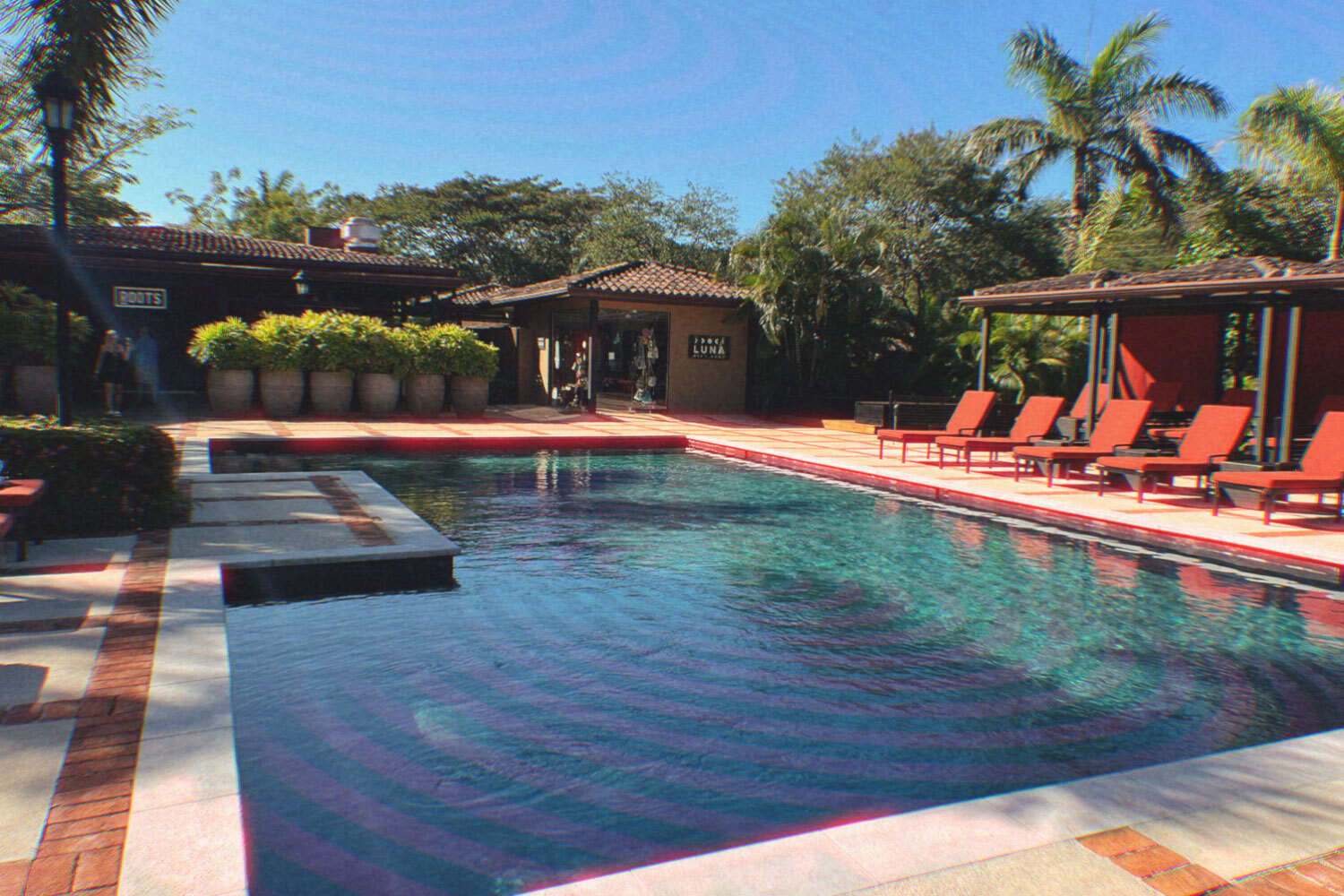
Part Three: The Process
A week before the retreat, I found myself feeling a shift in awareness. This is what’s called the “pre-party.” The theory is that the plant knows you’re coming and starts working in your system in advance, like some mystical tentacles reaching out to welcome you to your new life. It was recommended I go on a diet of extremely clean food, avoid most supplements and medications (if not necessary), and I was encouraged to meditate, spend time in nature and avoid mental chaos. I stopped reading the news, replaced meat with vegetables and hiked more than normal.
These lifestyle changes quickly kicked off a change in perspective. It felt like some spiritual Marie Kondo had walked in and started holding things up, asking if they sparked joy or not. Things would pop into my brain that needed attention: experiences that showed where I’d gotten stuck, arguments that reached a boiling point, even triggers to all my greatest annoyances abounded — car alarms going off all night long, a plane seat surrounded on all sides by crying children. On the flip side, I felt immensely grateful for my life, like a veil had been lifted and I was looking forward to what was to come.
Like any logical person, I chalked all this up to the placebo effect of anticipation.
The previous week’s attendees were still there, laughing, hugging and sharing stories. It had the energy of the last day of summer camp, the moment when “Wind Beneath My Wings” starts playing and everyone cries and exchanges numbers promising to keep in touch forever.
I arrived in Costa Rica fairly trepidatious, still not really knowing what to expect when it came down to it — about the ceremonies, the center, the Rythmia crowd, any of it. I was armed with a wealth of other people’s perspectives, experiences and opinions, but the inner realization that I really had no clue.
A taxi van picked me and a handful of others up at the Liberia airport for our hour-and-a-half drive to the resort. You could immediately tell the newbies from the returners. All of us first-timers looked terrified. There was some nervous laughter, a few awkward smiles at each other, all of us clearly wondering what demons each person possessed to bring them here. But mostly, there was silence. I suspect we were all thinking the same thing: Do I actually need this experience? Maybe I’ll just buzz my therapist for a good chat.
An introductory video played on the ride and outlined the concept and rules: Act as if you’re in a healing center. Don’t photograph others without their permission. A few other tidbits about the resort. All fairly basic.
We were handed an intake form, a little bag of nuts, a bottle of water. Slowly people started to open up. My first friend, Tim, who I had taken for a Hollywood mogul type, turned out to be a military veteran from Oregon whose family had sent him to do some much-needed emotional housekeeping. He had been to war. He had experienced personal loss. He was disappointed with Veterans Affairs for their limited arsenal of tools to help him and those like him.
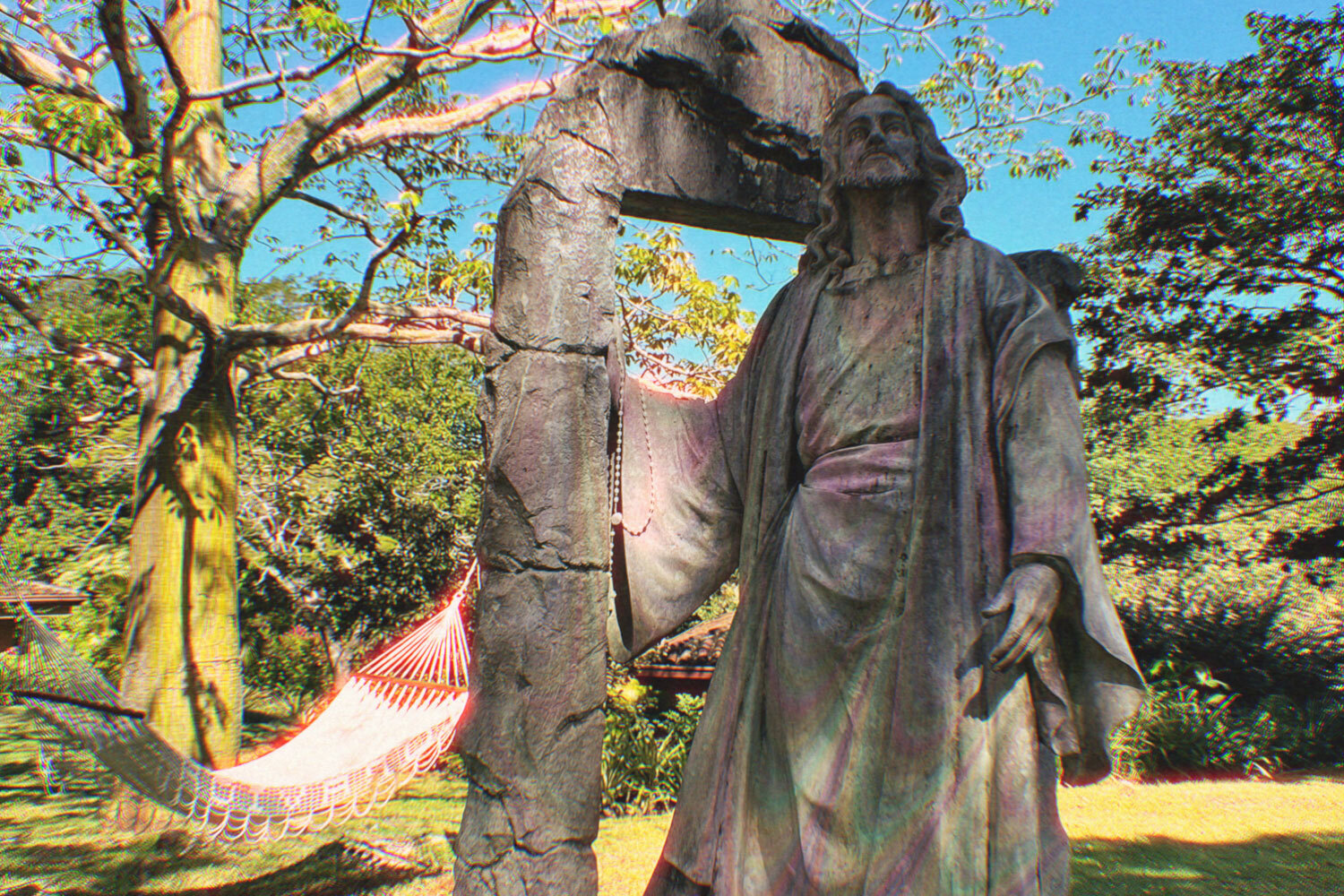
The check-in looked fancy, like any beautiful resort positioned in a jungle setting near the coast. This is where we would spend the next seven days, four of them drinking hallucinogenic tea. We were handed a tote bag and our ayahuasca cup. The vessel was a small, white ceramic glass, about the size used for tequila shots, with the Rythmia logo stamped on it. It seemed so very small in my hand. We also received an electronic bracelet that would check us into classes and sessions to keep track of our attendance and preferences for the purpose of collecting data on which ones are most effective and desirable.
The standout feature at reception was a scrolling LED sign, one that wouldn’t seem out of place at a car dealership, proclaiming today’s “miracle rate” at 97%. “Your miracle is in the forecast,” it read. I rolled my eyes.
My brain latched onto the world “miracle” and decided to deconstruct it in defiance of the tacky sign. According to our friend Webster, a miracle is defined as: 1) An extraordinary event manifesting divine intervention in human affairs; or 2) An extremely outstanding or unusual event, thing or accomplishment.
One can take issue with how frequently the word “miracle” is thrown around, yet if you consider the broadness of the definition, waking up in the morning is a miracle. Fine, the LED lights could have their fun.
After check-in, we headed to the tail end of dinner. The previous week’s attendees were still there, laughing, hugging and sharing stories. It had the energy of the last day of summer camp, the moment when “Wind Beneath My Wings” starts playing and everyone cries and exchanges numbers promising to keep in touch forever. Tim and I found a seat in a corner trying not to look like the geeks in a John Hughes film.
I am an unabashed foodie. I don’t want to be plagued with flavorless health food ever. The food at Rythmia successfully walked the tightrope of nutritious and tasty, and the crown jewel was coconut water on tap. After all, hydration is key when you are about to spend a week exporting your malignant spirits via bodily portals. My first obstacle felt overcome: I wasn’t going to starve.
When dinner was over, golf carts offered us a ride to our rooms, but we opted to walk, mostly to release some of the nervous energy. My room was spacious and comfortable, but leaned simple, and there was no TV. Instead, a colorful mandala painting with geometric designs hung on the wall; over my bed, a decal with the phrase “Surrender is the ultimate freedom” seemingly offered both advice and a preview. Sleep came fast.
I woke up early to the deep, resonating sound of howler monkeys echoing from the surrounding jungle. The grounds were peaceful and spread out. Colorful macaws performed acrobatics in the trees and painted the sky as they flew. I walked three miles exploring the grounds, getting my bearings and attending the orientation classes and medical review. The space doesn’t dissuade religion, but instead caters to a variety of beliefs. If you would like to pray by the statue of Jesus, you are welcome. If you prefer Buddha, he’s there as well.
The saltwater pool and spa quickly became my favorite areas. I spent down time swimming, coating myself with volcanic mud before dipping into the hot and cold pools, and sweating in the steam room.
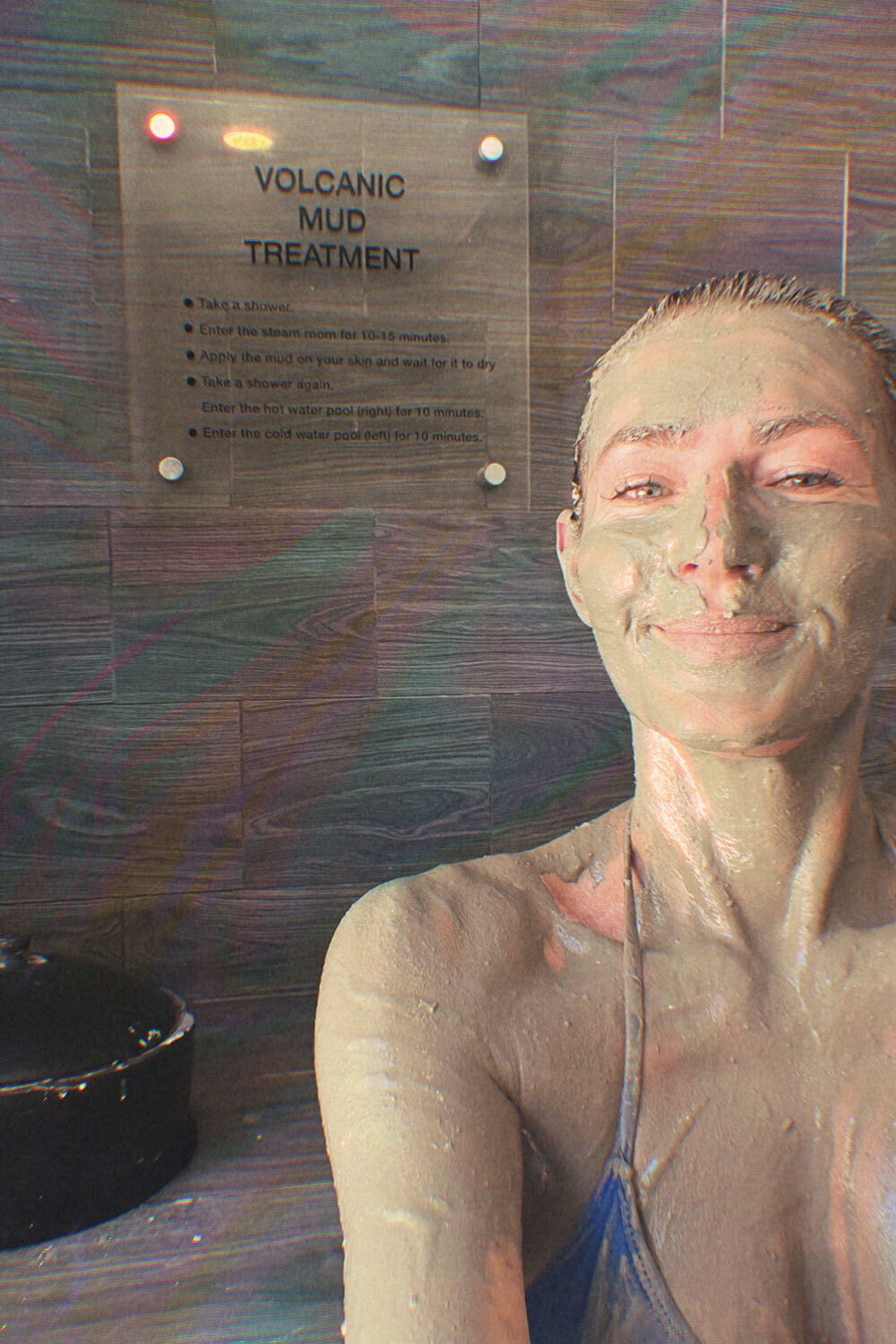
The first day I skipped yoga, because I hate yoga. Because it’s hard. Because I’m not flexible. Because it makes me sweat. Because the environments where it is practiced quite frankly make me uncomfortable. It has always felt pretentious to me, with people pretzeling themselves in their designer attire on their sweat-wicking mats with their crystal-infused water bottles nearby.
This hesitation also illustrated my biggest fear of the whole trip: being trapped for seven days with a demographic that grated on me in the most profound ways. Would it be the crowd I know from Los Angeles, whose reputation for jumping on and destroying any spiritual trend preceded them? I wondered if I would go slowly mad listening to people drone on and on about connections to their spirit animals and enlightenment at drum circles on Venice Beach, musing ad nauseam about their spirituality and lack of ego with the effervescence of a well-worn doorknob.
Instead, I met an assortment of humans, each seeking something unique, eager to pull back the layers of whatever was constricting them. I toasted coconut water to our future self-awareness with a retiring radiologist looking for another way to be of service to humanity. I cold plunged with two psychologists keen on learning more about the role of plant medicine in trauma therapy. I ate dinner with a taco-stand owner and a single mom both carving a path forward in life. I lathered volcanic mud with dancers, musicians and veterinarians desperate to heal life’s wounds. I walked the grassy labyrinth with lawyers and pastry-store proprietors all there to lay down their burdens. Humans I was pleasantly surprised were open to the experience. Some brought their parents, some their adult children. Some came as couples, many came alone. It seemed like every walk of life was represented.
In our group of 70, our oldest attendee was 71 and our youngest 18. (Their oldest attendee to date is 88.) Some saved up for the experience, some flew in on private jets, some were on a Rythmia scholarship, offered to those who cannot afford the retreat — all looking for this nebulous goal of a miracle. The cost of the center varies based on the package you choose and how many others you share a room with. Roughly five to nine thousand dollars for a week is what a luxury soul cleansing will set you back.
The people I got to know were vulnerable, and many were nervous. Some had been harboring traumas for years not knowing how to heal and losing faith in available options. For several, this was a completely new experience, one entirely out of their comfort zone. Many had never heard of ayahuasca or Rythmia until a hairdresser, an Uber driver, a guy at a wedding mentioned it and piqued their interest. Some had worked with psychedelics, many had not. Some were here as a secret from their families who they claimed wouldn’t understand. And indeed, people spoke about spirituality and enlightenment, but somehow it felt nice.
One psychologist left after the first night because he didn’t like the assault on his body with the vomiting and diarrhea and decided he would rather invest his energy into other healing practices. Another participant returned to his old habits shortly after.
Rythmia is a well-orchestrated blend of modern clinical center, ancient wisdom and a splash of sparkly woo-woo. It quickly became apparent that this is an ayahuasca retreat popularizing a traditional medicine for a modern audience — a center for those needing a little more guidance, and a little less trek through the jungle. This therapy is, by legal definition in Costa Rica, medicine. Those of us who enroll in the program are technically patients, but what really sets Rythmia apart are the classes.
After a day of getting one’s bearings, the feeling becomes far less luxury resort and more university campus, but a university where no one bats an eye if you’re wandering around barefoot in the grass meditating or popping in for a colonic between sessions.
The classes are highly recommended, borderline mandatory and truly invaluable. The data the center has amassed on how the ayahuasca works medically and on a consciousness level is pretty astounding. They covered everything from logistics, science, personal stories and guidance to open-sharing platforms and advice on how to make sense of the experiences. We were invited to come in with intentions, prayers and asks, but told the plant targets what is truly needed. It heals by priority, they said. It will shake the pillars of what created a situation in the first place, so chances are your ask will fall along with the entire pillar.
Bookending the immense amounts of information, advice and insight, we were given a recurring mantra: “You can’t screw this up.” Oh, really? I most certainly felt like I could.
The second night, we did a breathwork class. It was held in a dimly lit room with music and guidance from a Costa Rican teacher who led us through increasingly intense rounds of breathing. Scented oils were dabbed on our heads and the sounds of rhythmic breathing from across the room felt like a wave of energy being released. It was more powerful than I had imagined such sessions could be. People, including myself, burst into tears. If this is just our own breath shaking things loose, I wondered, what is the plant going to do to us?
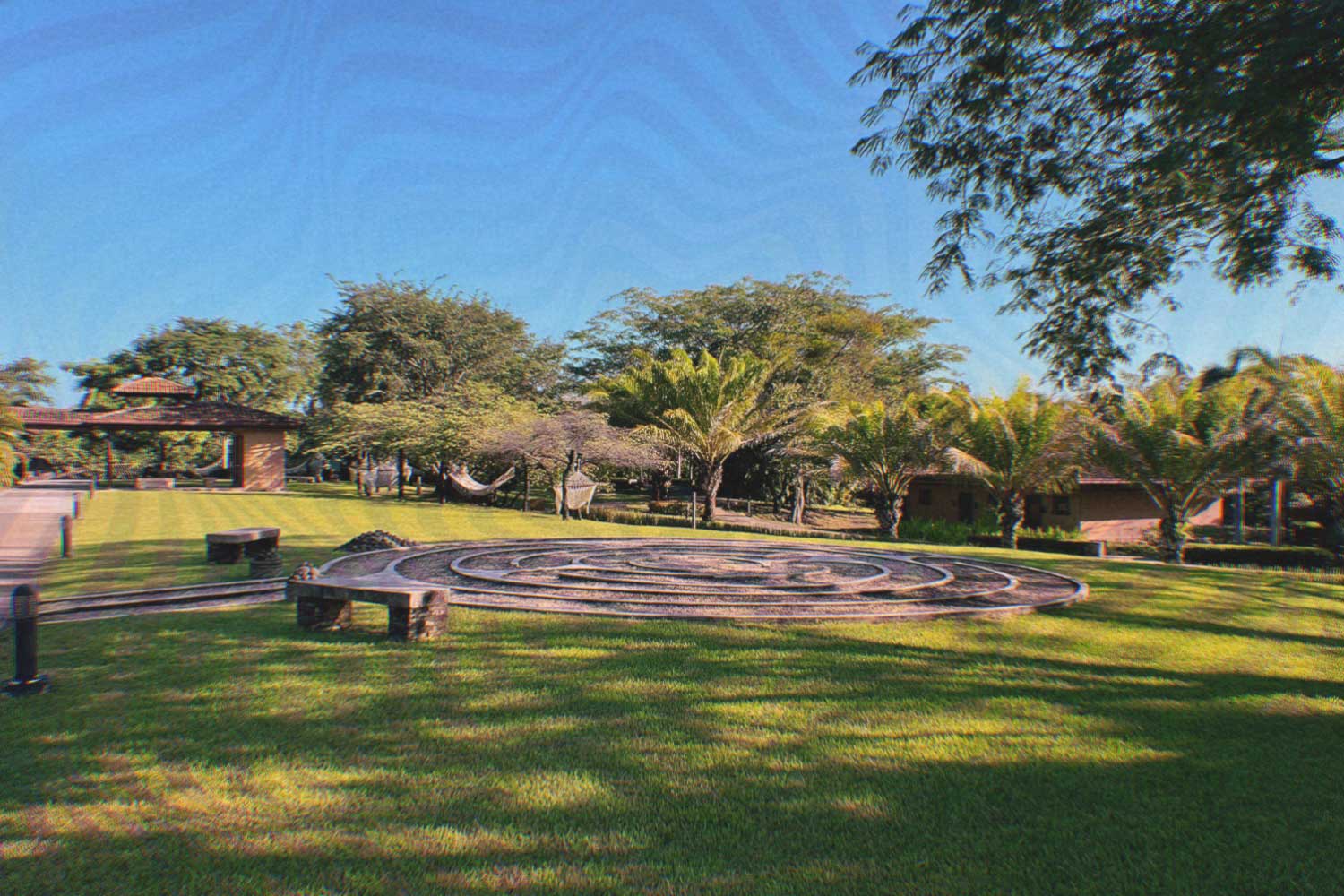
The following night, at five o’clock, we gathered for the first plant-medicine ceremony. Once again, the newbies stood out, wide-eyed with anticipation. Okay, pretty much fucking terrified. The ceremony is held in a maloca, a traditional Amazonian structure used for gatherings and ceremonies. This one was a big open space with high ceilings, huge windows and fans. Lots of fans.
Inside, we each found a space with our own neatly organized mattress, pillow, eye mask, blanket and plastic purge bucket. The bucket reminded me of something you might take trick or treating, which felt both ironic and on point. We were given the logistics of how to behave. Noble silence is observed. We were not allowed to speak or touch each other so everyone could process in a safe and silent space. Most importantly, we were told the location of all the bathrooms.
At the front of the room sat the shaman and his team. Around the room sat the helpers who were there for us if we needed anything. Because Rythmia is a medical facility and takes that title seriously, medical staff stand by just in case. Recent studies indicate that ayahuasca is generally considered safe when administered to otherwise healthy adults in a controlled environment like this; side effects are common but not usually severe, and it is challenging psychologically and physically, so having someone there to at least hold your hair back from the bucket is a nice bonus.
The shaman blessed the medicine with chants and sacred ceremonial smoke and we approached with our cups for the drink. My hands were shaking as I walked up. I was excited, but the unknown always tickles your alert mechanisms. If you enjoy drinking blended up bark with a pungent flavor of earth and nature with the thickness of molasses, this is your lucky day. For the rest of us, getting it down was the first challenge.
The Strange Story of Ior Bock
Out-there sex practices, revisionist world history and madness — this mysterious Swedish-speaking, Finnish eccentric is the most fascinating cult leader you’ve never heard ofThe intimate details of the ceremony and what I observed about the experiences of other individuals are sacred and personal. It would be disrespectful to the shamans and their cultures, as well as to the other participants, for me to describe them in detail. The other issue, which has not often been noted in other accounts, is that in describing the rather mysterious nuances of the ceremonies without context, a whole lot of background, education and the personal understanding that only comes from being in a particular space at a particular time, you do great disservice to anyone who might be interested in partaking. From the outside, it most definitely sounds like all marbles have been lost. Imagine describing a day at Disneyland complete with log rides, a giant talking mouse, cotton candy, Space Mountain and the Haunted Mansion to a caveman. I doubt that would go over well. Most things also hinge on how you choose to portray them. As journalists, we wield the power of the lens and of the pen. If I wanted to make things sound scary, from Disneyland to ayahuasca, it’s very simple to do.
Are the ayahuasca ceremonies wild, wacky, bonkers and out of this world? Yep. However, at no time did I feel unsafe, and the end results ultimately outweighed the discomfort I felt.
The details of purging, diarrhea and visions are fairly well documented — and yes, they are absolutely true. The reality is that you are mostly laying there with an eye mask on having one hell of a wild ride through your inner channels, doors of memories flying open. Occasionally, you might wander outside and look at the stars, have yourself a good cry, dance to the music or need some help getting past something difficult. I puked. I ran to the bathroom. I never had to change underwear. Glory was mine.
The ceremonies took place over four nights and each was led by a different shaman and their team. They started at around 5:30 p.m. and ended around 2 a.m., though that varies depending on the number of participants. My group of 70 was considered on the bigger side. My friend, Justin Walter, who attended a few months prior, had 17 in his group. His experience and the positivity towards life he came back with were a huge draw for me to go. He was able to release deeply-rooted blocks to happiness in his life that had seemed unshakable throughout our entire 15-year friendship.
Each night, we followed the same structure. After drinking the first cup, we would lay down and wait.
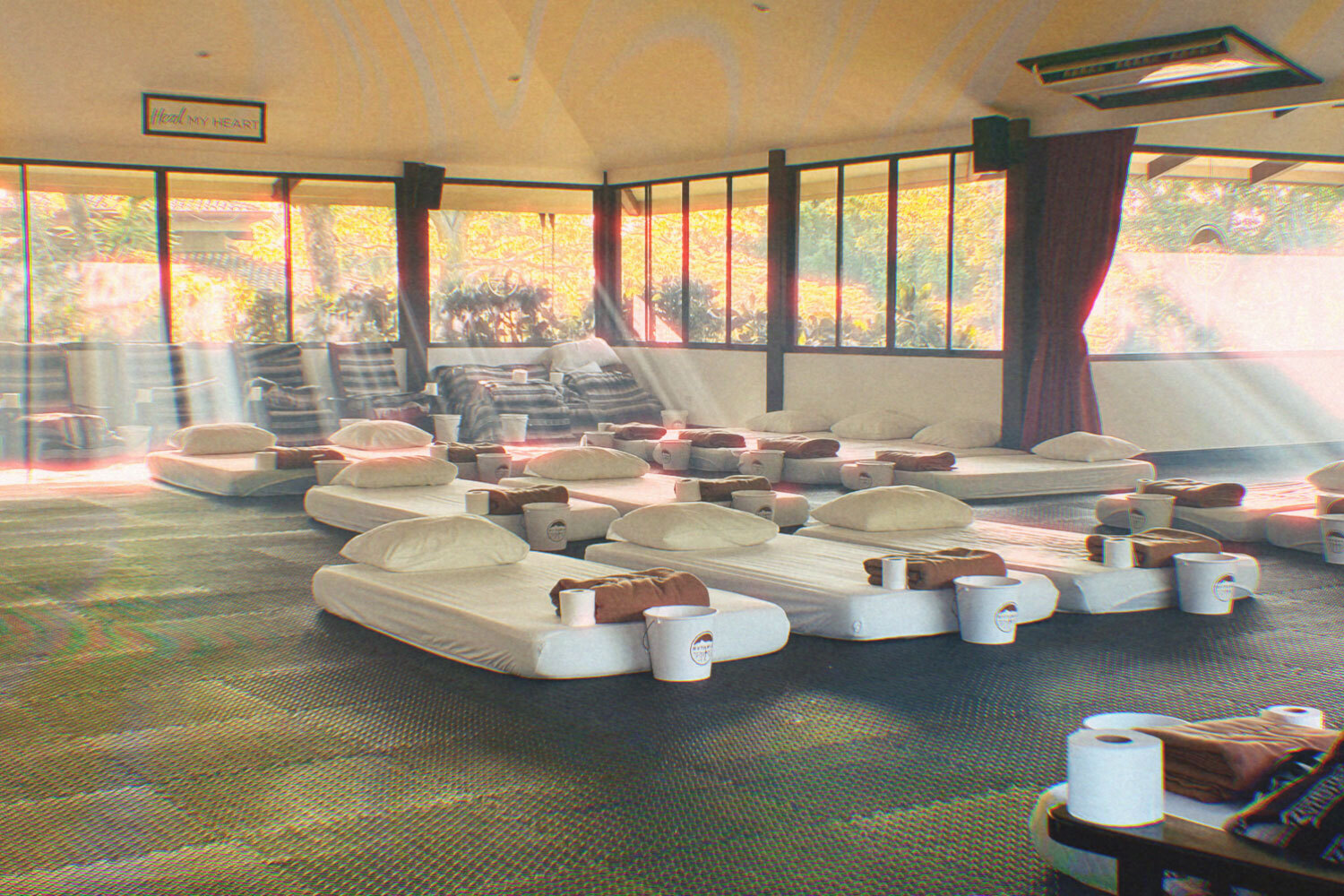
Part Four: The Journals
My experience, as is any with ayahuasca, is incredibly personal. There is no right or wrong, no expectations to be had, no idea of where it will go. Every cup, every moment can be completely different. You might go from facing some of the most difficult moments of your life to immense gratefulness for other parts of your existence. It really is just about surrendering and buckling up for one hell of a ride. While I won’t be sharing certain details, these are direct excerpts from my journal after each of the four ceremonies, with some added context.
Night One
My hands were shaking as I approached the maloca. People had lined up early to find a good bed, but I was at the back of the line. Right before we went in, a flock of macaws flew overhead which we all took as a sign of good things to come. It felt like they were watching over us.
“I drank four cups. Not much at first and I felt forgotten, overlooked. Then I got super irritated. I HATED the music. It was absolute torture. Awful. I wanted to run away outside. Then it occurred to me that I always run away outside when things get uncomfortable. I take solace in nature, which is great, but I don’t stick around to face things. I asked to be shown more and I realized I’m constantly irritated. Everyone and everything annoys me. Bugs me. I also felt itchy and hungry and overall grumpy. I saw how easily I let things get under my skin. Car alarms, people’s actions, kids on planes. So much of what I witnessed in the week before. Then she showed me moments in my life when I felt betrayed. I saw scenes from my life and felt the sting of those moments. I understood why I don’t trust openly. Rough night.”
Night Two
I was so tired from the night before and getting up for 7 a.m. yoga. I was vacillating between feeling like the medicine had accomplished something and accomplished absolutely nothing. I took my shoes off and grounded myself in the grass to feel better before I went in. The cool feeling of earth on my skin helped soothe me.
“Tonight was all about body healing. I felt the plant working on my body, especially the left side. I cried that I don’t want my heart broken and that I want to love and be loved without fear. I asked for my heart to be healed so I could walk in courage and not fear. I saw the spirits of my grandmother and great aunt and a community of grandmothers behind them all there to support me. I loved my body, moved and hugged myself. I was acutely aware that I am so little and fragile but fight so hard and carry so much and just want to be loved and protected and feel safe. The Hawaiian healing prayer song, Ho’oponopono, came on and I cried and cried. Then I felt more annoyance at music and sounds, and deep frustration. I didn’t go sit at the closing tonight and instead wandered around and felt woozy. I’m not sure what I think about all this and what I’m getting out of it.”
Night Three
I spent the day in the pool. I needed it. I walked the grounds between classes and lay in a hammock pondering the experience. By the time I arrived at the maloca, I felt calm but a little nagging feeling of uncertainty pulled at me: What if this doesn’t work for me at all?
“Wow. Tonight kicked my butt! I had three or four cups and after the second I cried to get rid of fear. I realized that my whole life I have been operating from a place of fear. I was taken back to so many moments in my life when I was afraid and alone or chose to be alone for safety…when I sat by my locker in middle school for lunch alone, when I was in my childhood home in my room so often afraid, a deep fear of losing my parents when I was little. I kept asking to see the source of this fear…the fear of abandonment, failure, loss, not being good enough. I kept pushing and pushing until I finally saw the moment I was born and how sick I was. [I was born with Rh incompatibility. This is something I knew but had never given it much thought.]
“I watched the scene as I was immediately taken from my mom by unfriendly nurses. [I was born in Warsaw, Poland, and it was a very utilitarian hospital. Nothing warm or inviting about it.] I was so scared. I was left alone and it was dark. I approached myself as this scared child. I made the connection with my infant self to protect, shield and comfort. The scene changed.
“I felt like the fear was stuck and I couldn’t release it. I cried really hard and when I went for my third cup the shaman (it was a female shaman this night) worked on me for 20 minutes. Then I felt immense gratitude for the women in my life, friends, strangers. I realized it was always women lifting me up. I was so grateful. I also realized people have always been mirrors, and others triggers showing me what I need to heal in myself. I thanked and forgave all the people who have brought me grief. I felt such gratitude for women in my life. I also felt so much love for myself and I hugged and held myself. I stood outside under the stars and they were so beautiful.
“I realized how much and how fiercely my mom has always stood by me, how much she loves me unconditionally and protected me at all costs. She has always been my guardian. I saw so many moments in my life when she stood up for me.”
Night Four
This was the big night with the head shaman, Taita Juanito, of the indigenous Inga tribe from Colombia. Tonight the macaws greeted us again and once more they brought comfort. The sunset was beautiful as we walked into the maloca and I felt more at ease with the last three nights behind me, but aware that tonight might bring more of the unexpected.
“I met shaman Taita Juanito and asked him to help my heart even more. He asked, via his translator, if I had had visions. I said yes. He said, ‘Drink more, go deeper.’
“I had one cup and I puked. I couldn’t for the life of me get up for more. I asked for a second pillow and I got so cozy. I felt so safe and secure like I do when I’m at my mom’s house. I ‘slept’ all night, even though I wasn’t traditionally asleep and could hear all the commotion going on around me. I was at peace and so relaxed. The only vision I had was a white light opening over me.
“Afterwards, I told Taita of my experience and asked if I messed up, if I did it wrong, because nothing happened. He laughed and said, ‘Bueno.’ Via his translator he explained that I was on a different plane and the medicine was healing deeply and far back in my genetics and lineage. I felt great the next day. So well rested and happy.”
That was my experience. It has nothing to do with how anyone else’s unfold. We also shared a lot as a group and there were some truly powerful transformations, revelations and deep dives that were incredibly challenging and seemed to have a profound effect on people.
Tim, my military veteran friend from Rythmia, sent me his journal entries and gave me permission to share them. I read them and sobbed. They were wild, intense and vulnerable — vastly different from my experiences, yet also strikingly similar in certain ways. He wrestled demons, sometimes literally in his visions; he confronted the loss of his brother; he listened to his mother cry at the loss of her son; he went back to moments in Iraq and saw those who he tried to save but could not; he felt himself die and be reborn. Ultimately, I chose not to share his journals verbatim because they are difficult to understand outside of having been part of the moment. In layman’s terms, they’ll scare the bejesus out of you.
My closest friend at the retreat was a psychologist, whose mind was equally as analytical and proof-based as mine. (He asked me not to use his name.) We wanted results. The two of us would wander back to our rooms at 3 a.m., dazed and confused, dissecting our experiences. On some nights, we simply weren’t having it and couldn’t for the life of us understand why people came back for repeat visits. On other nights, we had some interesting revelations that we compared to how deeply other healing tools could reach. It truly wasn’t until conversations that started a week after the retreat and took place up to a month later that we both began to understand the full impact of how we had shifted in our lives.
One common thread I heard repeatedly from many participants was the presence of a former dog who had been a great companion. They were often there as guardians, guides, protectors and to offer comfort. It was very moving. I had no such visions myself, because cats were our family pets of choice, and apparently they are assholes even in the afterlife.
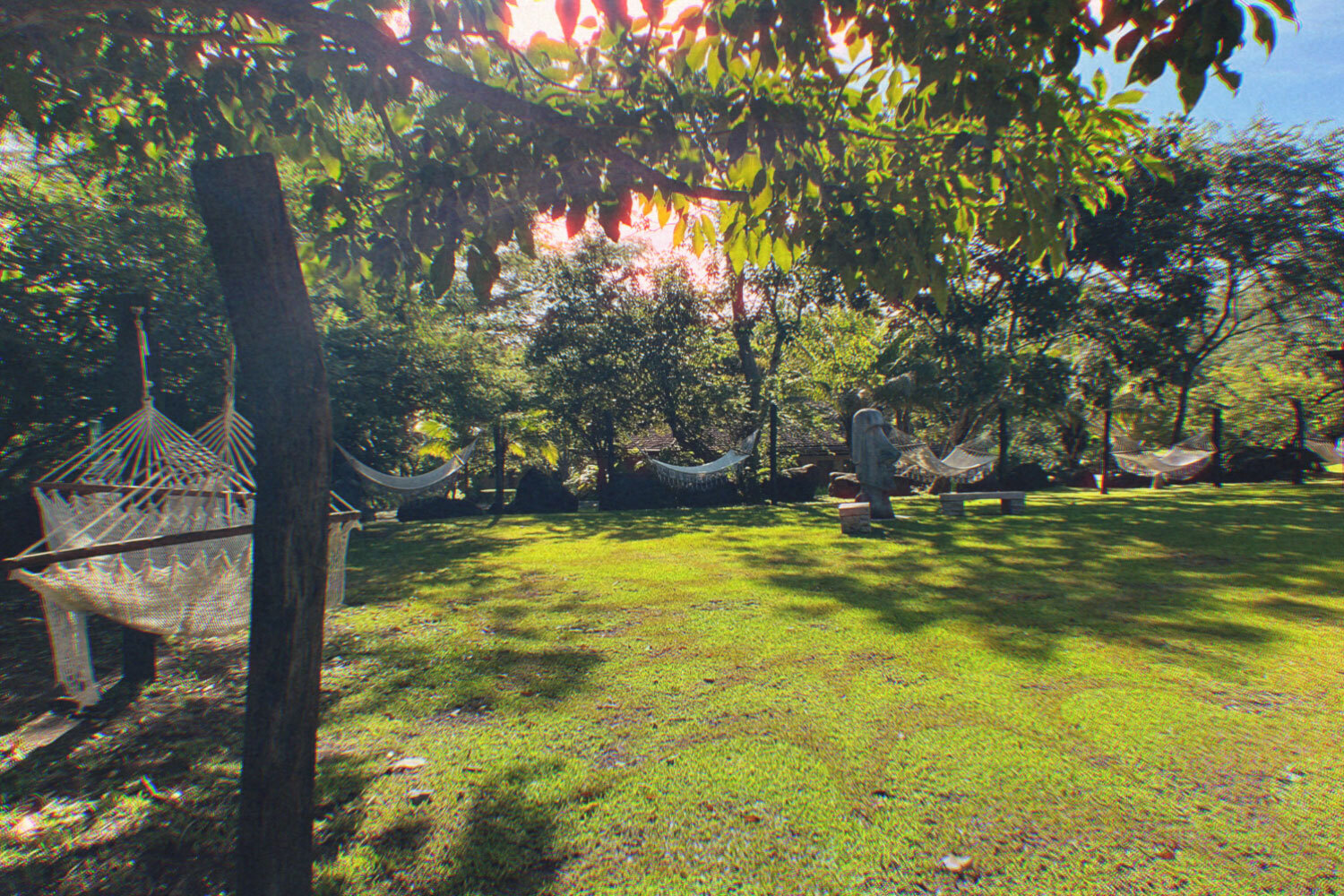
Part Five: The Return
Despite some deep digging into my memories and healing of life’s hurts, I didn’t leave feeling very different. In fact, I wondered if the ayahuasca had worked on me at all. I side-eyed the scrolling LED miracle sign again on the way out.
My extra few days in Costa Rica after leaving Rythmia were uneventful. I got up each morning, walked to the beach for sunrise and did a mental check to see if I was a shiny new me. I was not. Yet there was an almost imperceptible feeling that everything seemed a little brighter.
By the time I got home a week later, sticky situations felt like I could get through them much easier. I had trust in the process of life, the universe, God, whatever you want to call it. My friends commented that I seemed a lot more relaxed.
There was an increased happiness that I hadn’t felt in years, as if I suddenly looked at the world through different eyes, feeling joyful instead of anxious, noticing little details that made me smile instead of things that annoyed me. I was much more tolerant of situations that used to drive me crazy. Negative thoughts still entered my mind, but it was much easier to flip them to something positive. There was a sudden desire to follow my dreams again.
A month out, I started to notice that I was operating with far less fear. I was seeing situations more clearly as facts rather than my emotional attachments to outcomes. As someone prone to anxiety, my system was calmer than it had ever been. I stopped waking up with a pit in my stomach. My biggest breakthrough came when facing a recurring emotional trigger, which had always yielded the same result, like I was stuck on a loop. This time I chose a different path. I’ve done standard therapy, not 20 years worth, but enough to know that this plant highlighted and dug into parts of my psyche that therapy had not.
Ultimately, from what I experienced, ayahuasca is truly extraordinary in its ability to tap into emotional traumas and subconscious issues that are very difficult to get past. For me, it was the Drano to my biggest clogs; the elite special forces unit sent in when other divisions couldn’t get the job done. If it sounds completely supernatural, it shouldn’t, because these are some of the same strategies utilized by other therapies pervasive in Western culture. From Eye Movement Desensitization and Reprocessing Therapy used to buffer individuals to their trauma by having them recall and relive it, to Prolonged Exposure Therapy which creates a safe environment to relive and release trauma, there are some distinct similarities of approach.
It felt like ayahuasca was able to open the hidden doors of my mind with incredible accuracy, giving me access to the origins of stories I told myself. I saw a slideshow of my life, hitting on every point where I felt deep-rooted fear, and the show ultimately took me back to the first time I felt that emotion. By pulling the curtain back, the fears were no longer subconscious, and they could be processed and cleared. That’s simple psychology, but here my healer was not a therapist working off their education and experience with others, but a plant working off of my unique psychology, experiences and emotional composition.
The majority of us who attended the retreat walked away with valuable insight into ourselves. Call ’em miracles if you want. Call ’em pretty awesome life transformations if you rather.
Did it work wonders for everyone? No. One psychologist left after the first night because he didn’t like the assault on his body with the vomiting and diarrhea and decided he would rather invest his energy into other healing practices. Another participant returned to his old habits shortly after and hasn’t seen a profound change that could be called anything close to miraculous.
There are also legitimate questions to be asked around ayahuasca practice as well. Sustainability is a big one. The Banisteriopsis caapi vine takes several years to mature and thrives in deep, humid jungles, so natural reserves are limited. With the boom in plant-medicine tourism not slowing down, the most likely way forward will be commercial cultivation to prevent collapse of wild plants. Abuse of the medicine for recreational purposes and for pharmaceutical profit is a concern as well. The authentic practice lends itself to party use about as much as chemotherapy, but it’s difficult to predict how that might change with greater access. There are also semantics around how to describe plant medicine. The use of the word “drug” vs. “medicine” will have a profound impact on how people perceive, process and interact with it.
The business aspect of ayahuasca retreats is problematic for some. The truth is that for any practice for which there is demand, businesses will spring up to capitalize on it. That is economics. One can only choose wisely and support the ones which resonate with personal values. Any time a product becomes lucrative, even in the spiritual and healing space, you will find pseudo shamans, fake gurus, unholy holy men, spiritual charlatans and quack doctors.
A month later, I spoke to my psychologist friend who told me, “I’m sad because I’ve realized no treatment option we have available to us as therapists in a standard setting can compare to ayahuasca.”
I checked in with Tim, the military veteran who had fought his demons so fiercely, and he immediately replied via text, “Ayahuasca has been such a life-changing experience for me. My anxiety and PTSD are basically nonexistent anymore. I wish everyone who’s experienced trauma could have the opportunity we had. I am so thankful for the shift in perspective I have now. I literally still feel like any trauma from before Rythmia is gone. I understand those things still happened, but they don’t rule my life anymore.”
Brenda Bobby, one of the scholarship recipients, shared her experience with me two months after returning home. “It definitely helped me heal a lot of deep trauma and mental health challenges, however you cannot unlearn what is revealed, and the transition back in L.A. has been difficult for me,” she said. “The people, places and activities that have been ‘home’ no longer feel the same and it can be lonely and confusing. It has also left me feeling the need to return to plant medicine to gain deeper clarity and healing so that I can complete my purpose in this lifetime…but I’m so grateful I went and tell anyone who asks, it was worth the trip.”
I suppose that LED miracle counter was pretty accurate after all. I arrived as a skeptic and left lighter — pun intended — but I mostly mean emotionally.
Whether you’re looking to get into shape, or just get out of a funk, The Charge has got you covered. Sign up for our new wellness newsletter today.
